Best Preserved Geode in the World
Friday, January 27, 2023
The Pulpí Geode is a unique phenomenon in the world, given the size, perfection and transparency of the gypsum crystals. It is located inside a mine of iron and lead in the district of Pilarde Jaravía, at a depth of 60 m, coinciding with sea level and 3 km from the coastline of San Juan de Los Terreros.
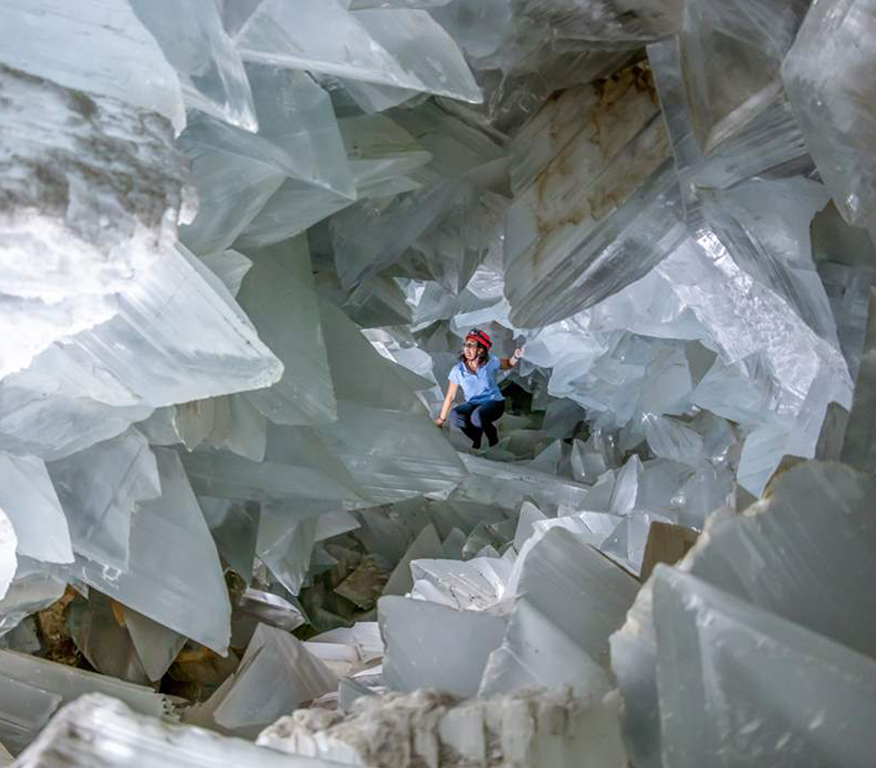
The geode is funnel-shaped, with the narrowest part an angled L-shaped hollow form 10.7 m3 volume, with 8 m long, 1.8 m wide and 1.7 m high. The average size of gypsum crystals is 0.5 x 0.4 x 0.3 m, with specimens up to 2 m long. Considered the best-preserved geode in the world, it was discovered by Angel Romero in 1999 inside an abandoned mine on the site of Pilar de Jaravía. It has been declared a Natural Monument.
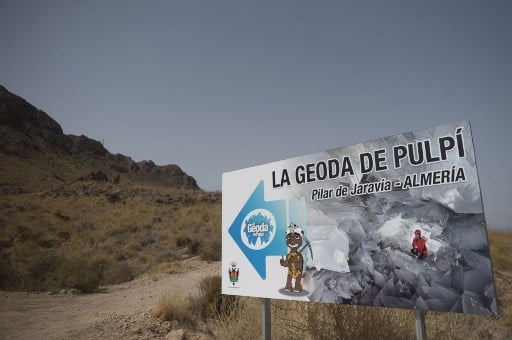
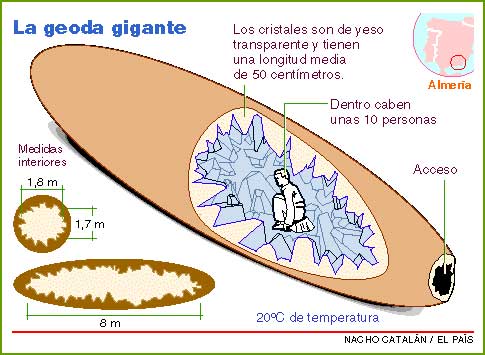

The largest geode in the world is in Naica (Mexico) and boasts crystals that reach 10 meters in length, but it is in a mine which suffers temperatures of 45ºC and with 100% humidity which makes it impossible for it to be visited by the public. However, the Pulpí geode is at a temperature of 20ºC and offers a more than acceptable humidity level. Therefore it is the second largest in the world but the only one that can be visited.
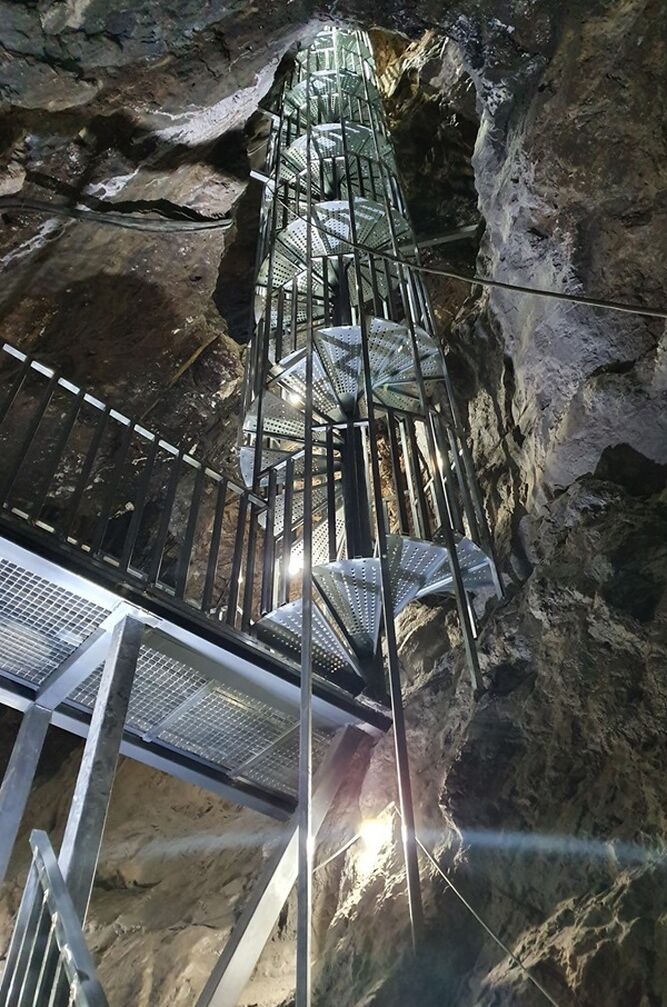
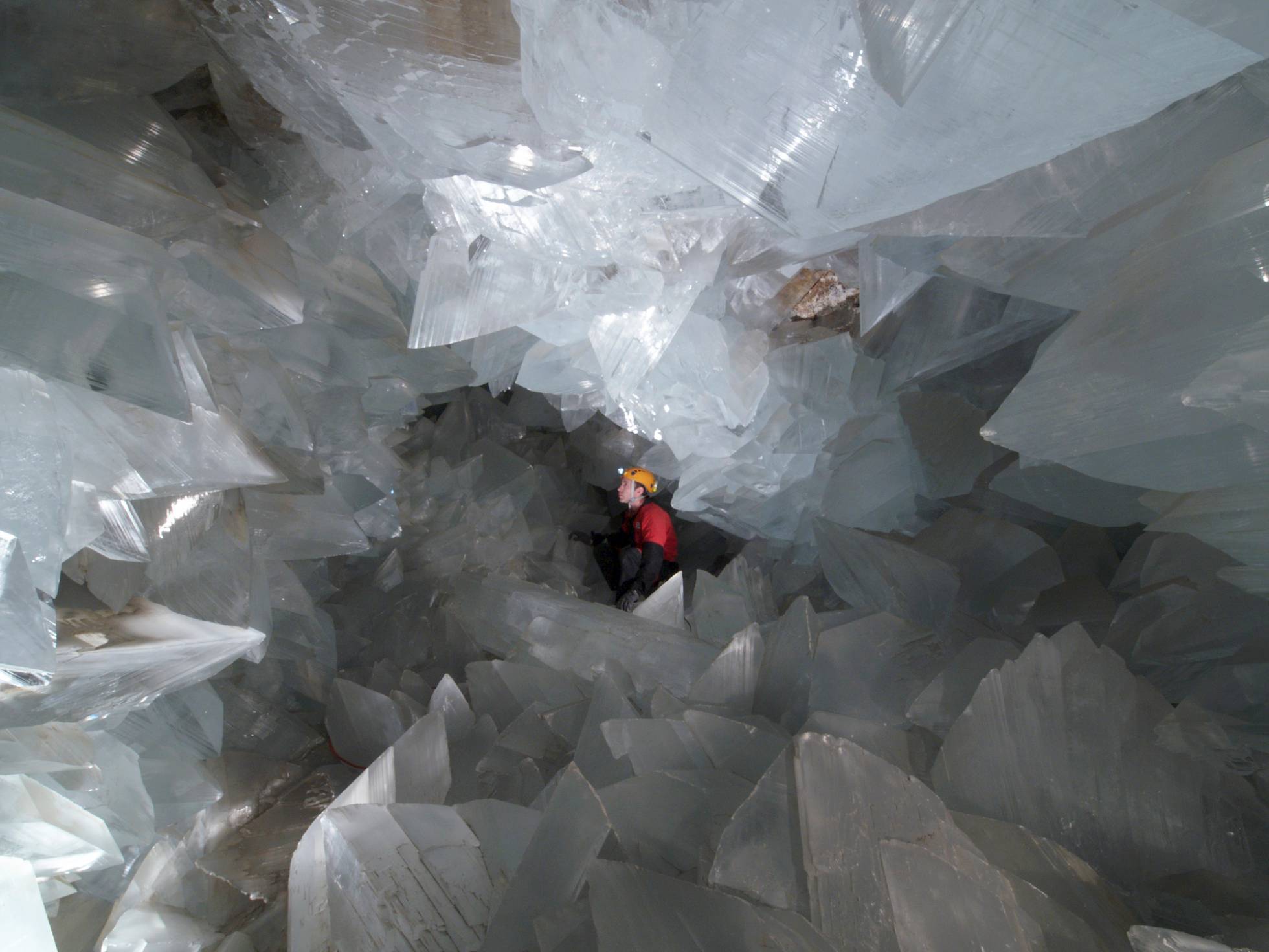
 0
Like
Published at 4:57 PM Comments (1)
0
Like
Published at 4:57 PM Comments (1)
2023 "Must-Visit" Destinations : Anaga Natural Park
Wednesday, January 18, 2023
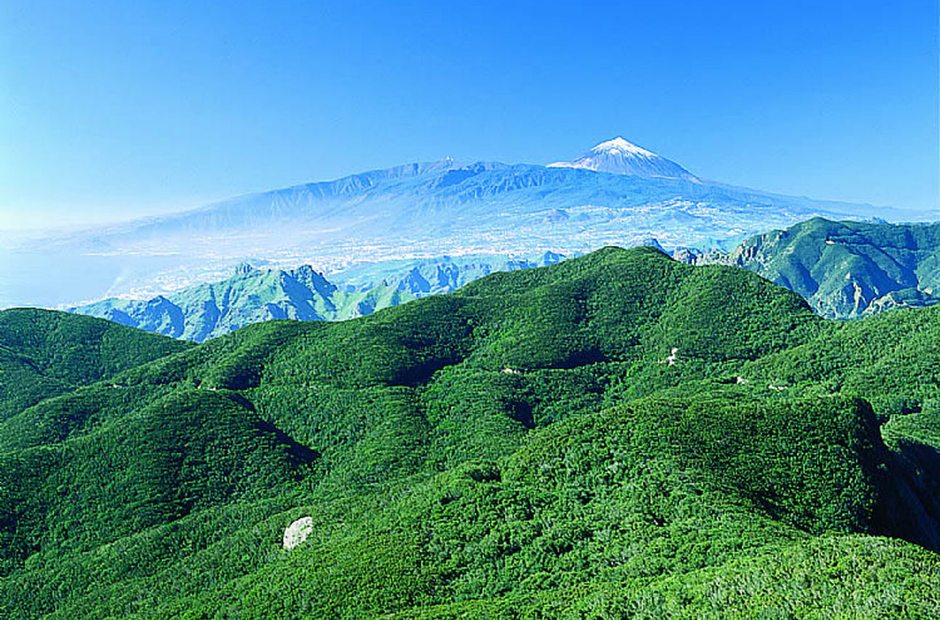
A stones' throw away from the capital, Santa Cruz de Tenerife, lies Anaga Natural Park, which has been declared a Biosphere Reserve and has surprisingly succeeded in preserving its natural beauty.
If you have the opportunity to visit you are likely to be overwhelmed by its beautiful precipitous mountain range full of sharp jagged peaks. The deep valleys and ravines that cut across it eventually reach out to sea, forming a series of beaches where you can wet your toes or have a dip in the ocean. Naturally, the park is home to a wealth of fauna and flora and abundant with autochthonous species.
Anaga Natural Park covers much of the mountain range located on the north-east of the Island. With an expanse of almost 14,500 hectares (35,800 acres), it crosses quite a significant stretch of Tenerife, spanning the municipalities of La Laguna, Santa Cruz de Tenerife and Tegueste. It represents one of the region's major leisure areas and is a wonderful tourist attraction.
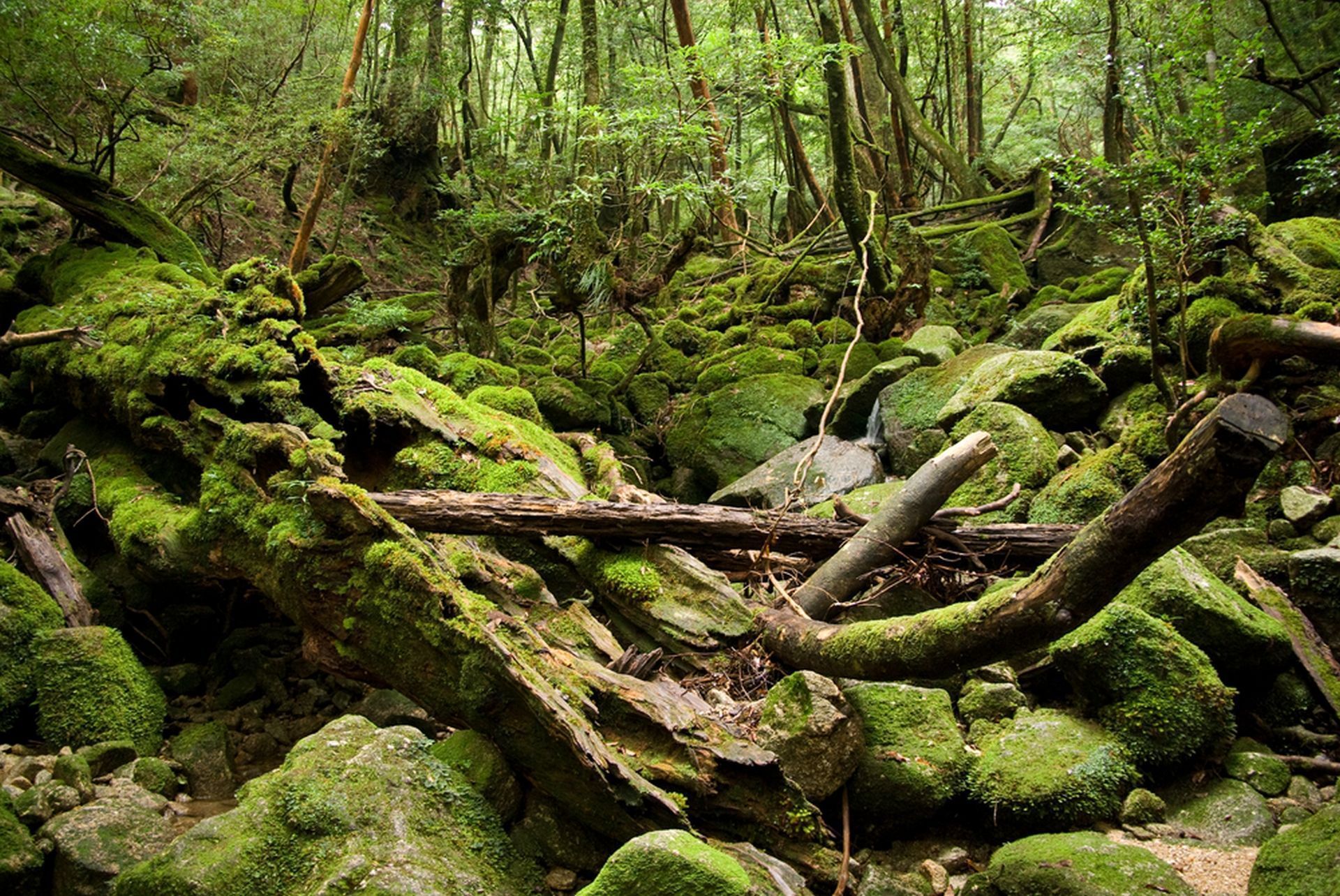
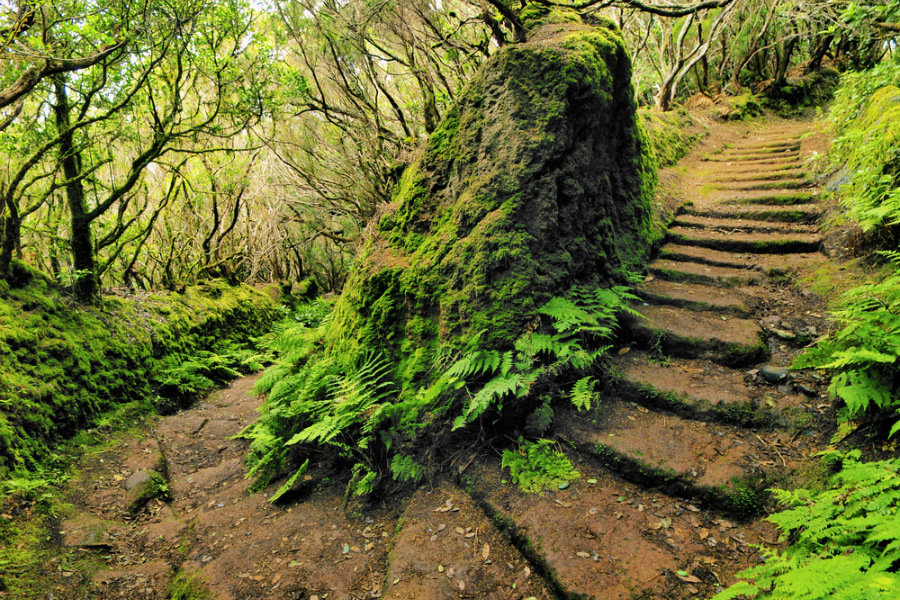
The impressive sight of its sturdy mountains rising high above the nearby sea is as attractive as it is unique. But if you really want to make the most of your visit, the best idea is to follow one of the many trails that will lead you to its charming little beaches of fine, shiny black sand (such as Benijo) dotted along the coast.

The area's landscapes are also adorned with geological formations such as "roques" (old volcanic chimneys), dikes (fractures filled with solidified magma forming sheets of rock that look like walls), cliff faces and deep ravines. Another of the area's unforgettable sights is, without doubt, the blanket of clouds.
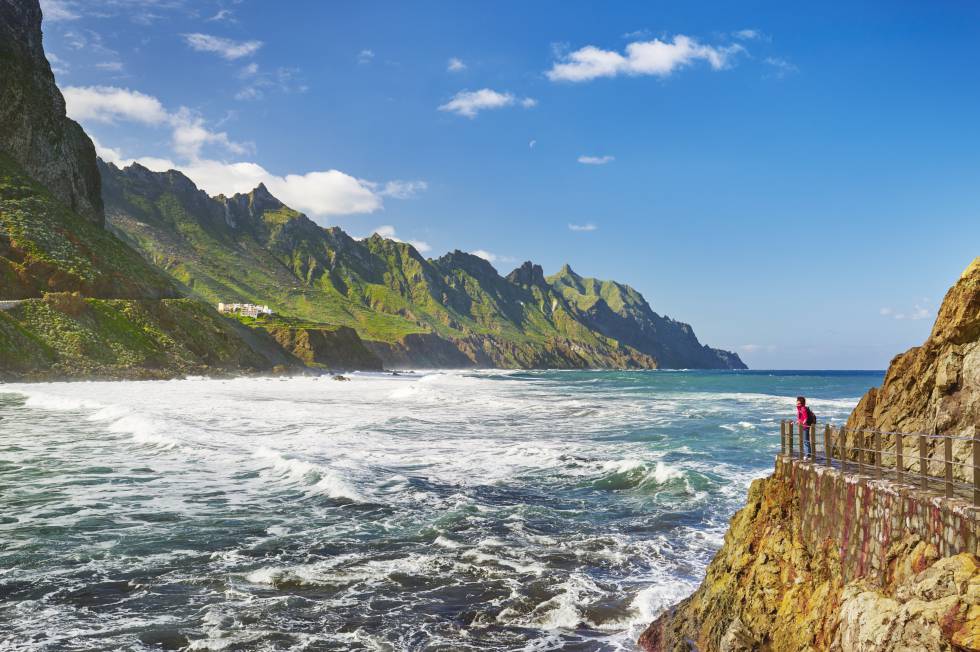
High up on the peaks you will find Tenerife's most wonderful areas of laurel forests. This vegetation could quite simply be classed as a living fossil, having survived more than 40 million years. The Mediterranean basin used to be covered in this greenery until the glaciers swept it away. A walk amongst this forest's twisted tree trunks lined with moss is like a journey back in time. Listen to the forest, feel it and breathe in its prehistoric air. As if all of this weren't enough, the Anaga mountain range is geologically one of Tenerife's oldest areas, which along with the varying altitudes, weather conditions and soils provide it with a huge biological diversity for such a relatively small space. Almost every kind of ecosystem on the Island can be found here, except high mountain flora and fauna. It contains coastal vegetation, populations of Canary Island spurges and euphorbia, dragon trees and Canarian palms.
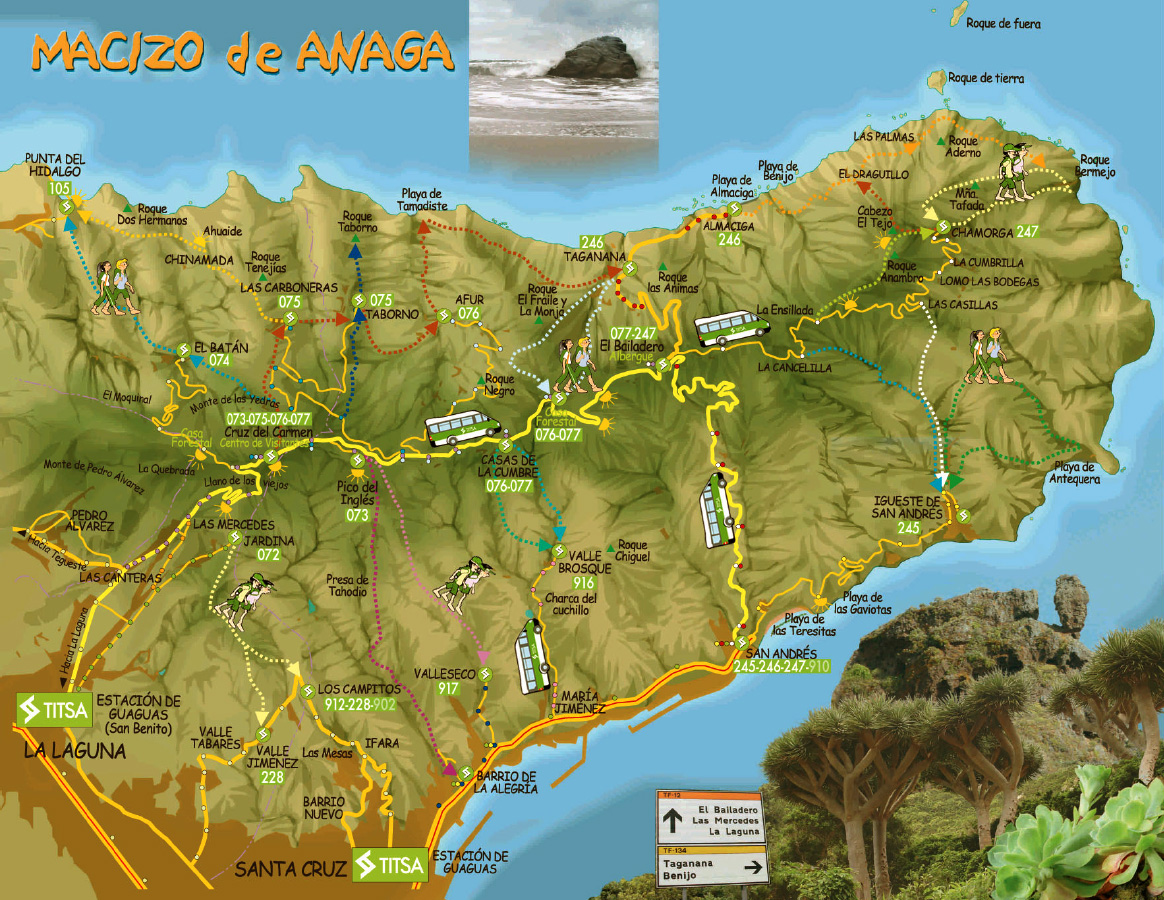
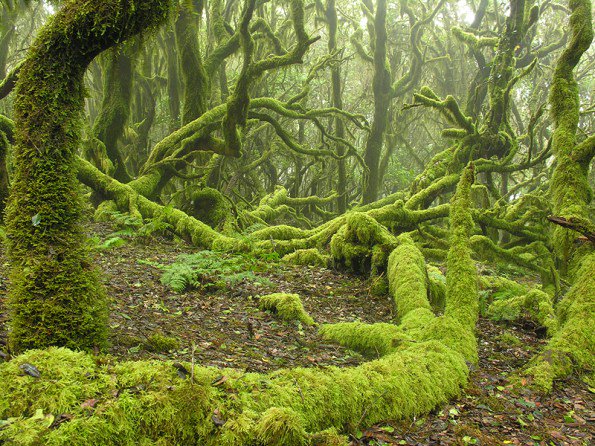
And where the flora is rich and diverse, so too is the fauna. The undisputed kings are invertebrates. You will find almost a hundred species here that are unique in the world. If you are a keen birdwatcher, you might recognise such emblematic species as Scopoli's shearwaters, kestrels, owls, Bolle's pigeons and laurel pigeons (both of 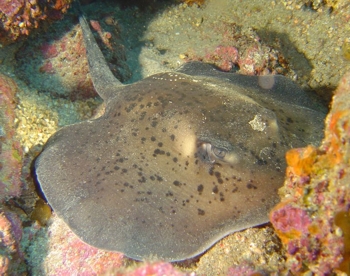 which are considered living relics and are native to the Canaries). In fact, the abundance of birdlife has led Anaga to become a Special Bird Protection Area. No less magnificent is the array of sea life, making quite a treat for divers, with such wonderful species as the Chucho (a type of ray), the Canarian cod, the Vieja and the endangered local eel. which are considered living relics and are native to the Canaries). In fact, the abundance of birdlife has led Anaga to become a Special Bird Protection Area. No less magnificent is the array of sea life, making quite a treat for divers, with such wonderful species as the Chucho (a type of ray), the Canarian cod, the Vieja and the endangered local eel.
The park also houses small villages and hamlets. You will find up to 26 inhabited by a total of 2000 people. Their residents live mostly off small-scale farming, tending traditional local crops such as sweet potatoes, potatoes, yams, vines and other fruit trees and plants.
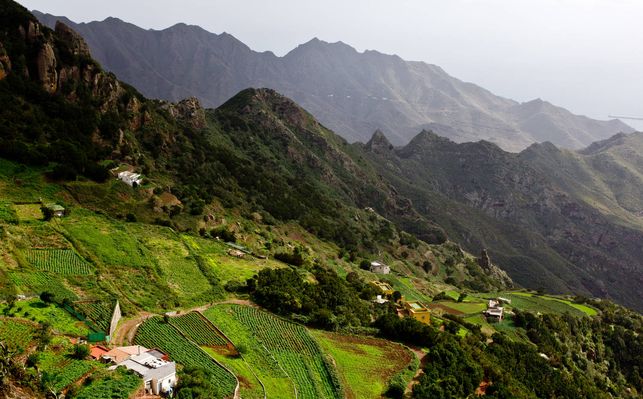
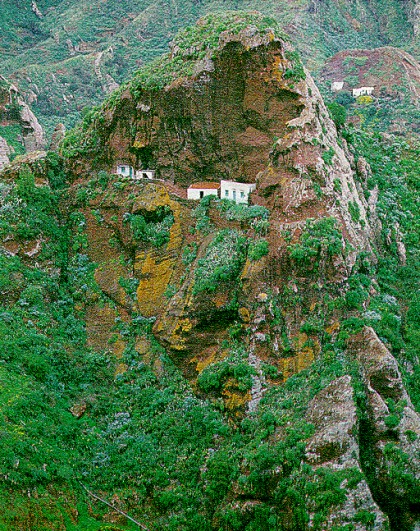
 1
Like
Published at 8:12 PM Comments (0)
1
Like
Published at 8:12 PM Comments (0)
Visit Seville's Restored Medieval Shipyard
Friday, January 13, 2023
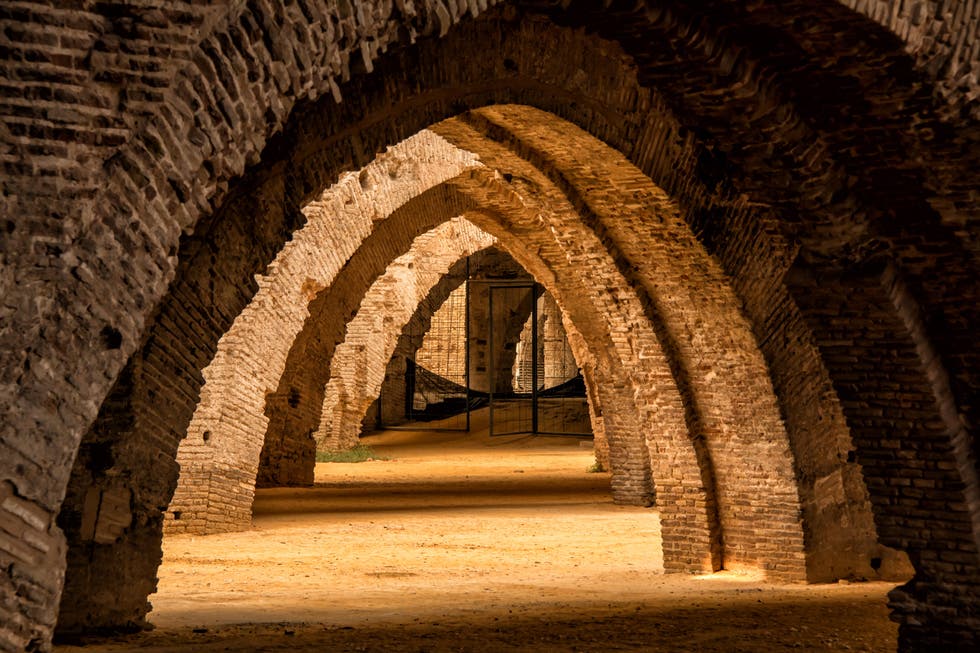
In 1248, Ferdinand III took Seville from the Moors, who had held the city since 712. It marked the fall, alongside Córdoba, of the two great Moorish strongholds in the Iberian Peninsula. Knowing that he still had to secure his position, Ferdinand III decided to launch a military campaign into northern Africa. In order to do so, he required a fleet of ships.
Ferdinand passed away in 1252 before realising his plan, but his son, Alfonso X “El Sabio,” proceeded with his father’s strategy. To build the fleet he needed large shipyards, so he initiated work on the Reales Atarazanas de Sevilla, or the Royal Shipyards of Seville.
Built outside the city walls and close to the Guadalquivir River, the shipyard covered about 15,000 square meters and consisted of 17 vaulted naves constructed entirely of brick, in a style now known as Mudejar-Gothic, with vaulted ceilings and wide arches connecting the naves. Construction was similar to those found in a church or cathedral. Each nave needed to be large enough for the construction of a galley, with each section of the shipyard connected to the next via a series of arches.
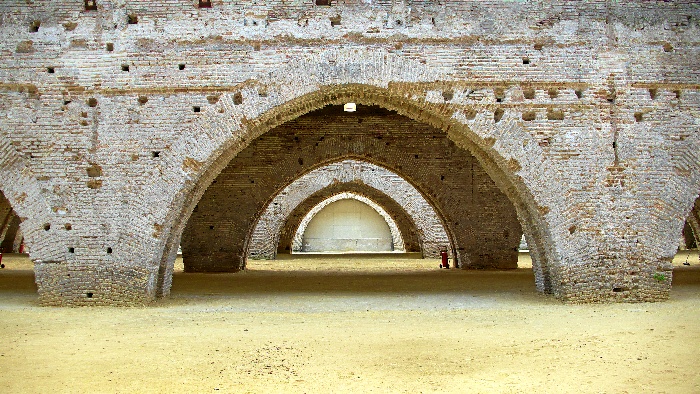
Before the end of 1253 ten galleys had been built in the shipyard, and it continued to produce fleets for subsequent Castilian kings. Galleys built in the Royal Shipyards of Seville were used throughout much of the remainder of the Reconquista, as well as during the Hundred Years’ War against England. During this time the naves were also used to hold prisoners and booty taken during the various conflicts.
By the mid-15th century and the final stages of the Reconquista, orders for new ships began to decline and the naves began to be repurposed for other tasks. In 1493, a fish market was moved into the first nave. During the 16th century, other naves were reassigned as oil and wool warehouses, and three more to house the city’s customs warehouse.

Time and technology had overtaken the Royal Shipyards of Seville. The naves were too small for building larger, more modern ships, and soon shipbuilding ceased altogether. In 1641, five naves were transformed into the Hospital de la Caridad. In 1719, five more naves were assigned for the storage of artillery material. The rest were largely used as commercial warehouses.
The next big change to the structure of the shipyard came in 1945 when five naves were destroyed to make way for the construction of the Delegación de Hacienda (Tax Office) building. Fortunately, no further destruction took place before the shipyard gained National Monument status in 1969, protecting it from further damage.
The shipyard, however, has been an ongoing problem for the local government. For more than 20 years it has been off-limits to the public, despite various plans and proposals for its renovation, all of which have so far failed, generating more frustration.
But in December 2018, it was confirmed that restoration would begin in 2019, with the aim of opening the Royal Shipyards of Seville to the public in 2022. Many Game of Thrones filming locations have become major tourist draws thanks to the popularity of the HBO series. So when the Royal Shipyards of Seville were used in season 7 of the show, interest in the location was naturally increased and the motivation to restore them revived.
So when the Royal Shipyards of Seville do finally open, expect the visitors to be a delighted mix of medieval shipbuilding aficionados and a crowd of Game of Thrones fans.
For more information : https://www.visitarsevilla.com/que-ver/monumentos/reales-atarazanas/
 1
Like
Published at 4:38 PM Comments (1)
1
Like
Published at 4:38 PM Comments (1)
Planet Mars in Spain
Thursday, January 5, 2023
Who would ever have thought that this landscape could be found in Northern Spain, a land of green pastures, valleys, vineyards, lakes and mountains? A terrain more akin to planet Mars or even the wild west - a scene with Peter O’Toole blazing his way to glory in the “Arabian” desert of Almeria. But this wonderfully mysterious land is just 70km from the ski slopes of the Pyrenees and holds the title of the largest desert in mainland Europe.
Bardenas Reales Natural Park is a place of wild beauty declared a Biosphere Reserve by the United Nations. It is a semi-desert landscape covering 42.500 hectares that is breath-taking and surprises anyone who might casts their eyes over it. An surreal spectacle in south-east Navarre, despite its bare and inhospitable appearance, is an oasis of natural assets.
The erosion of its clay, chalk and sandstone soils has sculpted capricious forms in the landscape to create almost lunar effects, full of gullies, plateaux and solitary hills. It has inspired painters and writers and has been the scene of TV adverts, music videos and films. A unique setting that seems out of place in Northern Spain and leaves nobody indifferent. You can visit this barren land on foot, by bicycle, on horseback or even with 4X4 motor vehicles. Specialist guides are available to help you to discover unforgettable spots with echoes of legends such as the famous highwayman Sanchicorrota, who used to fool his pursuers by putting his horse's shoes on backwards so they couldn’t follow him!

Bardenas Reales is a landscape sculpted over millions of years due to erosion. There are three distinct zones in the natural park which are, from north to south: El Plano, croplands characterised by very gentle slopes; the Bardena Blanca, the most photographed and visited area, where the main rock formations can be found in Castildetierra and Pisquerra. Also in this area, defined by its eroded crags, dry gullies and steppe-like appearance - in its lower part is a Firing Range used by the US Military, which explains the fighter planes; and the Bardena Negra, where the land darkens, giving way to the only Aleppo pinewoods in the area, accompanied by thicket.
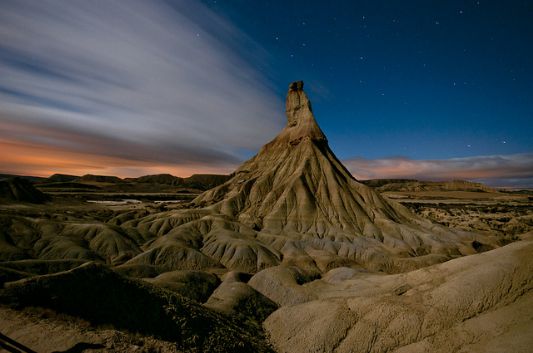
Exceptional viewpoints show the differences between its different zones. From the Alto de Aguilares you get the best panoramic view of the Bardena Blanca. The Balcón de Pilatos ('Pontius Pilate's Balcony') is an exceptional observatory of birds of prey. These high points show the wealth of this territory, which contains three Nature Reserves: the Vedado de Eguaras, an oasis to the north of the area where the ruins of the Castle of Peñaflor still stand; the Rincón del Bu (in Bardena Blanca), occupying 460 hectares, where the eagle owl breeds; and the Nature Reserve of Caídas de la Negra (in Bardena Negra), which covers 1,926 hectares and has altitude drops of 270 metres.
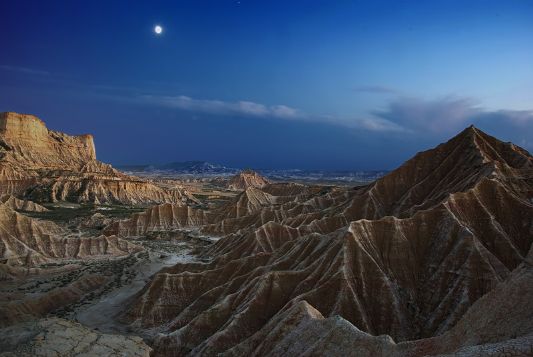
The Bardenas Reales Natural Park also offers more than 700 kilometres of paths, tracks and gullies that can be followed by hiking and cycling enthusiasts. Nevertheless, it is advisable to use specialist guides in your first incursion into the natural enclave. Apart from avoiding the risk of getting lost in the desert, they will help you to interpret the landscape with a flora and fauna more appropriate to an African desert than the north of the Iberian Peninsula. In the remote past it was even inhabited by crocodiles and turtles. Eagles, vultures, owls, great bustards, foxes, mountain cats, genets, amphibians and reptiles range between scrubland, sisal thickets, salt marshes and reed beds.
Due to the extreme temperatures and the special conditions of the land, it is recommend that one avoids going when it is raining. The best time to visit Bardenas is between September and June. On 18 September, if you have the opportunity go to the "Sanmiguelada", the day when thousands and thousands of sheep from the Pyrenean valleys make their way to this vast extension along El Paso to graze during the winter. To do this, follow the Cañada Real (royal livestock trail) of the Roncaleses which links up the pastures of the Roncal Valley with the Bardenas.
Places like this are what make Spain such a special country. One could even consider Spain to be a small continent as it offers almost every terrain you could possibly imagine, the choice and wealth of nature is far beyond what most people can even imagine, but wander away from the coastline and you can discover a world that will leave its mark forever.
Ver mapa más grande
 2
Like
Published at 1:05 PM Comments (4)
2
Like
Published at 1:05 PM Comments (4)
Spam post or Abuse? Please let us know
|
|